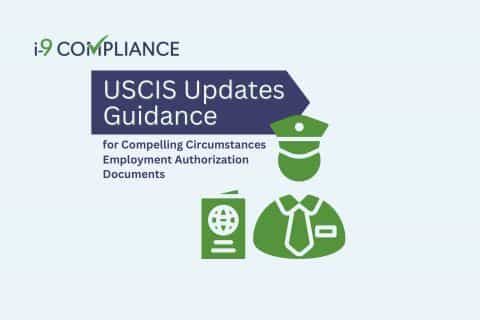USCIS Updates Guidance for Compelling Circumstances Employment Authorization Documents

June 30, 2023
The U.S. Citizenship and Immigration Services (USCIS) has provided new guidance for employment authorization documents (EAD). The announcement concerns the eligibility criteria when applying for EADs based on compelling circumstances. This guidance applies to initial and renewal applications, providing several situations the USCIS could issue as compelling circumstances.
According to USCIS, individuals may qualify for an initial EAD via compelling circumstances by meeting specific eligibility requirements. These include:
- “The primary applicant is the principal beneficiary of an approved Immigrant Petition for Alien Workers (Form I-140) in the 1st, 2nd, or 3rd employment-based preference category;
- The principal applicant is in valid E-3, H-1B, H-1B1, O-1, or L-1 nonimmigrant status or authorized grace period when they file the Application for Employment Authorization (Form I-765);
- The principal applicant has not filed an adjustment of status application;
- An immigrant visa is unavailable based on the applicant’s priority date, according to the relevant Final Action Date in the U.S. Department of State’s Visa Bulletin when they filed Form I-765;
- The applicant and their dependents provide biometrics as required;
- The applicant and their dependents do not have a felony or two or more misdemeanor convictions; and
- The USCIS determines, as a matter of discretion, that the principal applicant demonstrates compelling circumstances that justify the issuance of employment authorization.”
These compelling circumstances for the principal applicants and dependants include serious illness and disabilities, disputes with or retaliation from an employer, significant disruption to an employer, and more. In addition, the new guidance provides examples of evidence that an applicant may submit to prove that compelling circumstances exist.
For example, employers could include evidence proving the necessity of an applicant’s knowledge or skills to avoid significant harm or ruining a project. Another example concerns long-term leases or mortgage records. These must show that losing work may result in the individual selling their home at a loss if forced to return to their home country.
Once an individual’s compelling circumstance-based EAD gets approved, their spouse and children can apply for EADs. In addition, the USCIS will consider the principal applicant’s period of authorized stay. This consideration means they will not accrue a period of unlawful presence.
Furthermore, these EADs may have issuances for up to a year, allowing for 1-year increment renewals. As such, employees must renew their employment eligibility verification (Form I-9) annually. The best way for employers to track this requirement is by utilizing an electronic I-9 management tool. This tool provides step-by-step guidance and reminders to take action as needed.
When it comes to your work, automation makes eligibility verification quick and seamless. Get a head start today with I-9 Compliance.